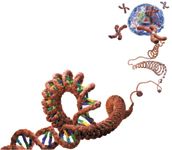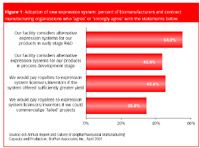Expression systems royalties battle
Pharmaceutical Technology Europe
Biopharmaceutical companies generally try to avoid paying royalties on novel technologies, including novel expression systems, in part because of the inability to predict revenue flow after a product is commercialized.
Biopharmaceutical companies generally try to avoid paying royalties on novel technologies, including novel expression systems, in part because of the inability to predict revenue flow after a product is commercialized. But even when a new expression system could significantly reduce cost, many remain hesitant. Despite this, adopting new technologies continues to be fundamental to improving product quality and cost.

"High tech industries adopt new technologies so they can produce better, cheaper, and faster. Sticking with what you know may seem safe, but in biomanufacturing this may have more to do with the lack of knowledge about emerging alternatives," says Ronald Rader, author of the BioPlan Associates report, Biopharmaceutical Expression Systems: Current and Future Manufacturing Platforms.1
Of course, one reason for the limited adoption of expression system technologies in biomanufacturing is the conservative, regulated nature of the industry. Tillman Gerngross, PhD, professor of engineering at Dartmouth College (Hanover, NH, USA), co-founder and CEO of Adimab Inc. (Lebanon, NH, USA) and co-founder, and exCSO at GlycoFi, which was recently sold to Merck & Co. (Whitehouse Station, NJ, USA), says that, "Making things cheaper while increasing regulatory risk has not been a winning formula in this industry; consider transgenic animals and plants."
Rather, Gerngross believes adopting technologies that improve product quality in ways that have a direct therapeutic impact is where the greatest value is added. Improved expression systems must do more than simply reduce costs. "Production costs are a small fraction of the final cost of goods — it roughly breaks down into a ⅓ production, ⅓ purification, and ⅓ formulation and QC." Therefore, cost-of-goods for a protein might be as low as 4%, which means reducing production costs will not significantly affect the overall cost structure, and that does not leave much room for royalties to the supplier of such technologies.
Adoption of new expression system technologies
As part of our Sixth Annual Report and Survey of Biopharmaceutical Manufacturing, we explored the potential for adoption of new expression systems (Figure 1).2 We were not surprised to find that 55% of respondents at biomanufacturing facilities indicated they would consider an alternative expression system in early R&D. However, we did find that 43% of respondents in process development stages would consider alternative expression systems. This suggests that for new drug products, manufacturing technologies are not written in stone.

Figure 1: Adoption of new expression system: percent of biomanufacturers and contract manufacturing organizations who 'agree' or 'strongly agree' with the statements below.
We also found that royalty payments for new expression system technologies were seen as much more acceptable to many biomanufacturers than we had expected. The acceptance of new technologies seems to be dictated by how a new system would improve manufacturing. For example, nearly 46% would pay royalties if the system offered greater yield, and 36% would pay royalties if they were able to commercialize their failed projects.
Sticking with old methods
The historical reasons that biopharmaceutical organizations are now primarily using the triedandtrue, common protein production expression systems stem from the industry's conservatism. Today, there is a need for increasing titers. Many believe that as long as the large numbers of current manufacturing projects using conventional expression systems continue to improve, the demand for novel systems will stagnate. "It is a conservative industry — nobody ever got fired for using E. coli, yeast, or CHO," says Gerngross. Many in the industry expect alternative expression systems to make strong headway, but only when they go beyond simply reducing costs, and provide such advantages as improved therapeutic properties.
License or acquire?
Pharmaceutical companies requiring technology improvements may also consider company acquisition. In 2006, for example, Merck acquired GlycoFi for $400 million to access its yeast glycoengineering and optimization technology. GlycoFi's technology is designed to produce therapeutic proteins more effectively in Pichia pastoris (yeast) instead of Chinese hamster ovaries (CHO) or NS0 cells, offering improved speed and quality.
Such outright technology acquisitions can be cleaner than technology deals that involve some kind of risk–reward sharing with time, where both the product developer and the innovator company share the risk if product sales do not meet expectations.
Another concern with licensing and royalties is 'royalty stacking'. Though more common in drug product licensing, it is one of the risks technology adopters face. Royalty stacking is caused when multiple overlapping patents compel companies to obtain multiple licences. Pharmaceutical companies are increasingly hesitant to form alliances with biotechnology companies if potential royalty stacking issues exist.
Information on alternative expression systems and genetic engineering technologies is readily available.1 Most technologies can be licensed at reasonable fees for evaluation purposes, and most are available for commercial license on a nonexclusive basis. Some expression systems may be licensed exclusively. This generally costs more than taking a nonexclusive licence, but can provide insurance against your product competing with another similar one.
Although technology licensing increases costs through licensing fees and royalties based on annual product revenue and sales, it is often the only prudent option for most organizations. Licensing is the only legal and fair method of using technology developed by others, particularly if covered by patents. Most organizations, whether biopharmaceutical companies, CROs, CMOs, universities or government laboratories, seek to license out any relevant technology that they have invented and patented to get some return on their investment.
Licensor organizations generally will work with companies to tailor licences to their needs. This may involve various combinations of upfront and postmarketing fee arrangements. For example, a small company may prefer to pay a lower upfront licensing fee in return for somewhat higher royalty rates on eventual product sales. Those confident that a technology will be used to manufacture one or more products may prefer to pay higher upfront fees with lower back-end royalty rates. For major products, including blockbusters, this approach can save hundreds of millions of dollars during the course of a product's commercial life.
Many technology sources are receptive to providing a limited licence for access and use of their technology for in-house evaluation purposes. Some companies and noncommercial organizations with expression systems in development may be eager to collaborate with companies that will use their technology for product manufacture.
With the pharmaceutical industry being very conservative, and with companies and regulators having distinct preferences for proven, known technologies, companies among the first to commercially manufacture a product using a newer technology can provide its developer with realworld costofmanufacture data and the references needed for wider commercialization of the new technologies. Thus, those among the first to license a new expression system or related genetic engineering technology can often receive better licensing terms, although the risk of failure or problems obviously increases with being among the first adopters.
Unlike licensing of actual product candidates, most licensing of process technology will be done in the relatively early stages of product development. Because a large number of technologies is available from many sources, there is more competition. This can tend to keep licensing terms down and increase the predictability of licensing terms and royalties associated with manufacturing technologies, compared with licensing of product candidates. Thus, in comparison with licensing of candidate products, licensing of manufacturing technologies tends to be more competitive and predictable in terms of fees and royalties.
Are new technologies worth the cost?
For an industry based on innovation, newer manufacturing technologies can be vital for a company's survival, and thus worth the expense, time and effort involved. Older technologies have the advantages of predictability and regulatory acceptance. When considering that many of these technologies entail lost opportunities as we move into the future, older technologies may find themselves increasingly limited by their performance.
Eric S. Langer is President and Managing Partner at BioPlan Associates, Inc. (Rockville, MD, USA). He is also the editor of Advances in Large-scale Biopharmaceutical Manufacturing and Scale-up Production, and a member of BioPharm International's Editorial Advisorial Board. Tel: +1 301 921 5979 elanger@bioplanassociates.com
References
1. R. Rader. Biopharmaceutical expression systems and genetic engineering technologies (BioPlan Associates, Inc., Rockville, MD, USA) 2008.
2. Sixth annual report and survey of biopharmaceutical manufacturing, 2008–2009 (BioPlan Associates, Inc., Rockville, MD, USA) 2009.
This article was first published in the April 2009 issue of BioPharm International.

Drug Solutions Podcast: A Closer Look at mRNA in Oncology and Vaccines
April 30th 2024In this episode fo the Drug Solutions Podcast, etherna’s vice-president of Technology and Innovation, Stefaan De Koker, discusses the merits and challenges of using mRNA as the foundation for therapeutics in oncology as well as for vaccines.
Drug Solutions Podcast: Applying Appropriate Analytics to Drug Development
March 26th 2024In this episode of the Drug Solutions Podcast, Jan Bekker, Vice President of Business Development, Commercial and Technical Operations at BioCina, discusses the latest analytical tools and their applications in the drug development market.